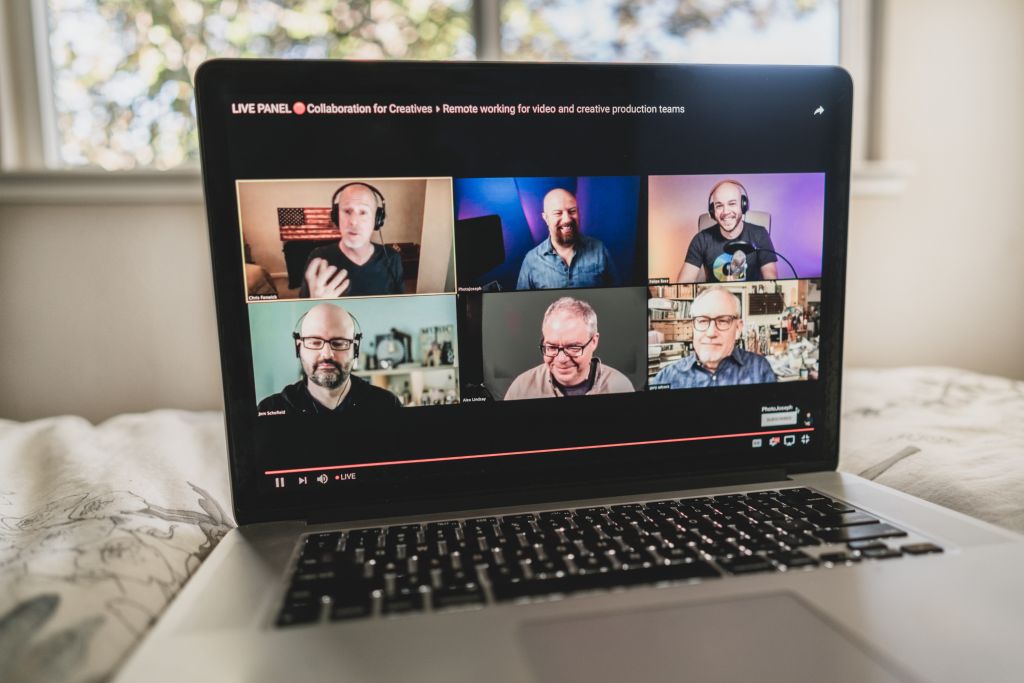7 Tips for Successful Remote Video Production

The COVID-19 pandemic has upended life (and business) as we know it. It’s essential to pivot your communications to meet your customers and teams where they are right now– at home, socially isolated, and uncertain about what the future holds. Messaging must be timely, consistent, and current– which means you need to publish quickly and effectively.
At SL\CE Editorial, we have been managing remote video productions and edits for nearly a decade– and we want to help your business adapt to this changing world as efficiently as possible.
If there’s anything the coronavirus pandemic has taught us– it’s that we’re all in this together. Although many of us will be working from home for the foreseeable future, there is an abundance of digital communications tools that can bring us together safely during these unprecedented times.
From interactive live webinars, to polished podcasts and professionally edited videos, we can help you optimize the technical and aesthetic details– so you can focus on communicating with your audience.
Keep reading for 7 tips on how to improve your virtual communications now!
3 Reasons to Embrace Remote Video Production Immediately
Remote Video Production is Fast
Undoubtedly, our world is changing fast. This means your business communications must reach audiences with unprecedented speed, as well.
Depending on your industry, your customers, investors, and staff may need to hear from you daily. Whether through interactive webinars or pre-recorded messages, remote video production can make it simple to stay in touch and stay relevant.
Remote Video Production is Authentic
Here’s a silver lining from the coronavirus pandemic– We now have an excuse to get personal. As the lines between business and home life start to blur, people are enjoying getting a peek into their colleagues’ lives.
It’s refreshing to strip away some of the polish of corporate communications and remind your audience that you’re human, too. While you should still maintain professionalism, don’t be afraid to show a slice of your home life. We all need an excuse to smile!
Remote Video Production is Cost-Effective
If your company is concerned about revenue, there is no need to splurge on a full 3-camera production with studio lighting just to get your message out in an engaging way.
Using branded graphics templates, PowerPoint slides, and webcam best practices, we can help you produce polished videos remotely, with less expense and maximum efficiency.
7 Tips to Improve Your Remote Videos Today
While you are likely familiar with video conferencing tools like Zoom, WebEx, and Skype, there are powerful features and best practices that can help take your virtual communications to the next level.

1. Optimize Your Lighting, Background, and Audio
There is so much you can do to improve the appearance and audio quality of your virtual videos!
Here are a few quick tips to get you started:
- Face towards your primary light source, ideally a window.
- Turn off or avoid any light sources behind you. Being backlit makes it hard to see your face.
- If you are using natural window light, turn off your interior lighting. This will keep your skin color looking realistic, and avoid the characteristic orange and blue tones of ‘mixed lighting.’
- Avoid messy or busy backgrounds. You can never go wrong with a plain wall, but be sure to sit a few feet away to avoid the ‘hostage video’ look. Remove branded items and logos from your shot, if they are not from your company.
- Consider framing. You don’t want to be too close or too far away from the computer. You also don’t want your audience to be looking up your nose or down your shirt. Adjust your camera to be roughly at eye level.
- Turn off any background noise, including washing machines and dishwashers if possible.
- Try to position yourself in a quiet room with carpet, blankets, and/or curtains to prevent echo.
- Mute your microphone when others are speaking. Many virtual communication tools have a keyboard shortcut that makes muting easy.
2. Mind Your Connection
Sometimes slow connections are unavoidable, but there are steps you might be able to take to improve your video quality for your audience or remote video editor.
- Plug your computer into ethernet if possible, and turn off your WiFi.
- Ask others in your household to refrain from streaming video content during the meeting or remote recording.
- Suggest that other attendees use ethernet, as well.
3. Record Locally for Remote Video Editing
Best practices for pre-recorded videos are a little different from live webinars. For the absolute best video quality, we can help you record your message locally to your computer– then transfer the file to us for editing.
From there, we can sweeten the audio and color, adjust framing, and add animated graphics and music to produce a polished, branded video you can share with your audiences.
Furthermore, this single piece of content can be repackaged and optimized for all your social and media channels!
4. Don’t Shy Away From Video Interviews and Group Panels
Although multi-person videos are much more complicated to produce remotely, we highly recommend giving it a try! Audiences love hearing multiple perspectives and real conversations.
Whether you need to produce a customer testimonial or an expert panel, we can help oversee the entire process remotely to ensure optimal quality.
Here are some best practices to keep in mind:
- Don’t speak over each other. Pauses between each speaker help enormously when it comes to editing the video down for content and concision.
- Coordinate similar framing for every participant. Make sure everyone is about the same size in the frame.
- Enlist a technical director to ensure that all content captured is optimized for live viewing and/or remote editing.
5. Consider Producing Animated Videos
Perhaps even the highest quality ‘talking head’ doesn’t fit with your brand or current messaging. Now is the perfect time to produce an animated video instead!
We have been managing animation projects remotely for years, from voiceover capture to storyboards, graphic design, and the actual animating work. Animated videos can be clean and simple or highly complex, making it easy to adjust the scope to fit your budget.
6. Collaborate in Real-Time in Our Remote Edit Suite
Whether you are producing an animated video, a remote interview, or a scripted statement, you can be highly involved in the post-production process by utilizing our virtual edit suite.
We’ve been using video conferencing tools for years to share our screen with our clients and let them peek over our shoulder in real time. This expedites review cycles, minimizes back-and-forth emails– and is almost as fun as visiting our physical offices in person!
7. Take Command Of The Virtual Meeting
Interactive live webcasts are great for communicating with many people simultaneously. It’s important to have complete control over your virtual meeting space so bad actors can not take over the audio and visual components, an increasingly common phenomenon that has been dubbed “ZoomBombing.”
You may need to dig into the preferences to optimize your settings for security. We recommend using passwords for all your meetings, and assigning a team member to host the meeting and screen everyone who enters. We have been helping our clients run their interactive webinars remotely, so they don’t need to worry about these technical details.
It’s Time to Act Now
Armed with some best practices and a remote video production partner, there’s nothing stopping you from engaging with your audiences in innovative new ways. Whether you’re an experienced virtual communicator or just getting started adapting to these tools, we are ready to help you get your message out with sophistication, ease, and speed.
Get in touch with us at info@sliceeditorial.com to learn more!

